2020 looks to be a very interesting year, with so many major planetary alignments and shifts happening. I list and discuss some of the most important ones in this article:
(Please note, I am a Vedic astrologer and all of my work is based on the sidereal zodiac, Lahiri ayanamsa. I do not use the tropical zodiac coordinates used by most western astrologers.)
1. Pluto and Saturn will make a rare conjunction on January 12, 2020, two days after the full Moon/penumbral lunar eclipse in sidereal Gemini, which will occur two weeks after the big Sagittarian solar eclipse of December 25-26, 2019. Starting the year off between these two eclipses and a rare planetary conjunction suggests a lot of intense changes and events in 2020.
The conjunction of Pluto and Saturn occurs every 30-35 years and has in times past been associated with danger, disasters, conflict, crisis, and socio-political upheaval including wars or economic upheaval. Using an effective 3-degree orb, Saturn and Pluto conjunction is in place in 2019-20 from:
- April into June 2019, in late Sagittarius
- December 2019 until January 23, 2020, with the exact conjunction occurring on January 12, 2020, in late Sagittarius
- January 23 to February 18, 2020, in an out-of-sign conjunction with Pluto in late Sagittarius and Saturn in early Capricorn
- September 10 to October 13, 2020 in an out-of-sign conjunction with Pluto in late Sagittarius and Saturn in early Capricorn
Some instances when the Saturn-Pluto conjunction happened previously include:
- In 1786 in sidereal Capricorn, during the time that Shays Rebellion occurred in Western Massachusetts (from 1786-87). It was an armed uprising in opposition to a debt crisis among the citizenry and the state government’s increased efforts to collect taxes both on individuals and their trades. This was an important watershed moment that brought attention to serious weaknesses in the Articles of Confederation that prevented the national government from effectively managing the country’s finances.
- In 1819-1820 in sidereal Pisces. During this time, the Panic of 1819 ensued. It was the first major peacetime financial crisis in the United States that was followed by a general collapse of the American economy that persisted through 1821.
- In 1914-1916 in sidereal Gemini, during World War I which lasted from 1914-18.
- In 1947 in sidereal Cancer, when India became independent from the British Empire following the Independence Movement led by Mahatma Gandhi and his message of nonviolent resistance. This is also the period when the Cold War began in response to the Truman Doctrine.
- In 1982-83 in sidereal Virgo and Libra, during the height of the AIDS epidemic which was also a period when there were three significant political assassinations or assassination attempts: Pope John Paul was wounded by a gunman; Anwar el-Sadat was killed by Islamic extremists; and President Reagan was also wounded by a gunman.
In the astrological charts for the Saturn-Pluto conjunction of January 12, 2020 (see below), we see a continuation and amplification of the Sagittarius solar eclipse chart of December 25-26. However, in this case for the U.S. chart, the Sagittarius stellium occurs on the upper meridian (midheaven or MC, relating to the current government crisis in the U.S.), and it involves Mercury (communication and media). Mercury’s energy is somewhat unstable as it is on the edge of the sign and it is also involved in a planetary war with Saturn, the planet of truth; while Mercury, Pluto, and Saturn are all combust, indicating power struggles and a heightening war of ideals and words in American politics.
This Sagittarius alignment points to all the revolutionary movements and the ideological/political and culture wars at play in the world now. As I have also previously written, I believe that the large planetary alignment in the Sagittarius eclipse axis indicates a great push for freedom (as with Brexit) and the revelation of certain previously hidden truths leading to the birth of a new world order in 2019-20. Uranus in Aries conjoined the ascendant in the U.S. Saturn-Pluto conjunction chart also suggests this. Jupiter’s presence near the MC and Sun, in trine to the ascendant and Uranus offers protection and the hope that light will prevail over darkness.
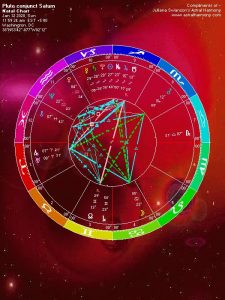
 The Rahu-lunar eclipse in Gemini occurs on January 10, 2020, two weeks after the Ketu-solar eclipse in Sagittarius of December 25-26, 2019. Looking at how these eclipses might affect us personally, the Sagittarius solar eclipse challenges us to sort out, break down, harvest, and release certain long-held beliefs, ideals, and aspirations. Moving toward the Rahu-lunar eclipse in Gemini, we may feel compelled to seek new ideas, understandings, possibilities, and choices for growth and empowerment as we create intentions for 2020 and the next decade.
The Rahu-lunar eclipse in Gemini occurs on January 10, 2020, two weeks after the Ketu-solar eclipse in Sagittarius of December 25-26, 2019. Looking at how these eclipses might affect us personally, the Sagittarius solar eclipse challenges us to sort out, break down, harvest, and release certain long-held beliefs, ideals, and aspirations. Moving toward the Rahu-lunar eclipse in Gemini, we may feel compelled to seek new ideas, understandings, possibilities, and choices for growth and empowerment as we create intentions for 2020 and the next decade.
Ketu and Jupiter transit together in Sagittarius in November and December 2019, and through much of January 2020. They will make their exact conjunction on January 6 (using the Mean Node calculation), and then will start to separate, but will both remain together in the same sign of Sagittarius through March, and then again during July, August, and into the third week of September.  Jupiter-Ketu conjunction occurs every 7-8 years, but in Sagittarius it is less common. The last time it occurred in this sign was in the late 1800s. In its more evolved expression, this conjunction points to spiritual wisdom, enlightenment, and philanthropy. It is called Ganapati Yoga in Vedic astrology, representing the blessings of Lord Ganesh. The Ketu-Jupiter conjunction in its lower expression may reflect fanaticism, including religious persecution and attacks on religious communities. This conjunction can generally signify extreme highs and lows, and sometimes will indicate a crisis of faith, including a tendency to wrestle with certain established values or beliefs. (Note: I wrote more about this conjunction in my recent eclipse article.)
Jupiter-Ketu conjunction occurs every 7-8 years, but in Sagittarius it is less common. The last time it occurred in this sign was in the late 1800s. In its more evolved expression, this conjunction points to spiritual wisdom, enlightenment, and philanthropy. It is called Ganapati Yoga in Vedic astrology, representing the blessings of Lord Ganesh. The Ketu-Jupiter conjunction in its lower expression may reflect fanaticism, including religious persecution and attacks on religious communities. This conjunction can generally signify extreme highs and lows, and sometimes will indicate a crisis of faith, including a tendency to wrestle with certain established values or beliefs. (Note: I wrote more about this conjunction in my recent eclipse article.)
I believe that the conjunction of Jupiter and Ketu in Sagittarius occurring near the start of the New Year is a sign of spiritual hope, and it is especially auspicious as it falls on the Epiphany, January 6, which is the “Day of Light” that closes the door on the 12 (or 13) holy days and nights of the Christological festival that began on December 24.
 2. After having transited in sidereal Sagittarius since October 26, 2017, Saturn will move into sidereal Capricorn on January 23 (and on January 24 in some parts of the world), and this will occur shortly before the New Moon of January 24. The transit of Saturn into a new sign represents a “sea change.” Saturn will transit in Capricorn until April 28, 2022, then will move into Aquarius briefly, and then back again in Capricorn from July 12, 2022 until January 17, 2023.
2. After having transited in sidereal Sagittarius since October 26, 2017, Saturn will move into sidereal Capricorn on January 23 (and on January 24 in some parts of the world), and this will occur shortly before the New Moon of January 24. The transit of Saturn into a new sign represents a “sea change.” Saturn will transit in Capricorn until April 28, 2022, then will move into Aquarius briefly, and then back again in Capricorn from July 12, 2022 until January 17, 2023.  Saturn last transited in the Capricorn constellation from 1990 to 1993, and before that from 1961 to1964. I find it interesting that the construction of the Berlin Wall, part of the Iron Curtain in Europe, began in 1961 but came down toward the end of 1989. So one transit of Saturn in Capricorn occurred with the wall’s erection, and the next cycle of Saturn in Capricorn saw it coming down.
Saturn last transited in the Capricorn constellation from 1990 to 1993, and before that from 1961 to1964. I find it interesting that the construction of the Berlin Wall, part of the Iron Curtain in Europe, began in 1961 but came down toward the end of 1989. So one transit of Saturn in Capricorn occurred with the wall’s erection, and the next cycle of Saturn in Capricorn saw it coming down.
In my astrological consultations with clients, I always pay a great deal of attention to Saturn transits as they describe much of the karmic path ahead. Saturn’s transit in Capricorn is very positive and strong for Saturnian themes concerned with justice, righteousness, fairness, ethical attitudes, and moral conduct. Saturn is the Sat Graha, Planet of Truth, and signifies the force of fate and karma, that which we have created that must come back to us.
Saturn represents constraints, reality checks, sustained effort, and practicality, and his purpose is to make us be more responsible for ourselves and our actions. A strong Saturn can help us target, streamline, consolidate, and manifest in whatever areas he is influencing as seen in the astrology chart. Generally, this transit is a good one for disciplined, focused action; goal-setting; effective work habits; and the achievement of our ambitions.
Capricorn is the abode of Saturn (the sign it rules), so with this transit, we will see a strong emphasis and advancement in Saturnian/Capricorn-themed areas which include, according to mundane astrology, those related to disaster relief; enterprise, industry, and employment; the laboring classes; the economy; safety and security; patriotism and nationalism; government, especially the judiciary; mining and land matters (farmers, farmlands, building or construction, engineering, and infrastructure); borders and trade between countries (continuing to tighten these up); elderly people, geriatric issues/aging; and the power to overcome disease outbreaks and economic crises that may arise.
Saturn will transit in Uttarashadha nakshatra (which spans from 26 degrees 40 minutes of Sagittarius to 10 degrees of Capricorn) from December 26, 2019 until January 22, 2021. This characteristically brings a lot of tumult for world leaders (as this nakshatra is ruled by the Sun), and especially when Saturn is retrograde in this asterism (May 11 to September 29, 2020).
3. Using a three-degree effective orb of influence, Jupiter will conjoin Pluto through much of 2020 either in early Capricorn or late Sagittarius. This alignment happens every 13 years and is a power combination that will bring enduring changes in the world. All three Jupiter Pluto conjunctions in 2020 are conjunct the asteroid Pallas, named after Pallas Athena, goddess of political nous, courage, just warfare, wisdom, and strategy. The dates for the conjunction in 2020 are as follows:
-
- March 12 to April 4, 2020, with the exact conjunction occurring in early sidereal Capricorn on April 4
- June 30 to July 29, 2020 at the tail end of sidereal Sagittarius, with the exact conjunction on June 30
- October 19 to December 1, 2020 in late Sagittarius, with the exact conjunction on November 12, 2020.
 Because Pluto’s transit all the way around the zodiac is so slow (248 years), the last time that Pluto and Jupiter conjoined in sidereal Capricorn was in 1784 when the Continental Congress ratified the Treaty of Paris, which officially established the United States as an independent and sovereign nation and granted the United States territory as far west as the Mississippi River (but reserved Canada to Great Britain). The last time they conjoined in late Sagittarius was during the American Revolution. However, in 2007 they conjoined n early Sagittarius in Mula nakshatra (this was the beginning of a great recession).
Because Pluto’s transit all the way around the zodiac is so slow (248 years), the last time that Pluto and Jupiter conjoined in sidereal Capricorn was in 1784 when the Continental Congress ratified the Treaty of Paris, which officially established the United States as an independent and sovereign nation and granted the United States territory as far west as the Mississippi River (but reserved Canada to Great Britain). The last time they conjoined in late Sagittarius was during the American Revolution. However, in 2007 they conjoined n early Sagittarius in Mula nakshatra (this was the beginning of a great recession).
4. Jupiter will transit in sidereal Capricorn in 2020 and 2021, from:
-
- March 29 to June 29, 2020
- November 20, 2020 to April 5, 2021
- September 14 to November 20, 2021
Saturn and Jupiter will conjoin in early Capricorn within a three-degree effective orb from the last week of November 2020 into mid-January 2021, and their exact conjunction will occur climactically on the solstice on December 21, 2020.
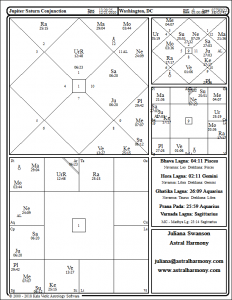 Jupiter is normally “debilitated” in Capricorn (weak, depressed, negative), but because it will conjoin Saturn which is dignified (strong) in Capricorn, this represents a significant cancellation of debilitation for Jupiter (neecha bhanga). My hope is that their conjunction can enhance the human capacity for goodness, decency, and altruism. It seems especially possible when they are both together in Uttarashadha, the nakshatra of humanitarianism, from March 8 to July 25, 2020 and again from October 30, 2020 to January 6, 2021.
Jupiter is normally “debilitated” in Capricorn (weak, depressed, negative), but because it will conjoin Saturn which is dignified (strong) in Capricorn, this represents a significant cancellation of debilitation for Jupiter (neecha bhanga). My hope is that their conjunction can enhance the human capacity for goodness, decency, and altruism. It seems especially possible when they are both together in Uttarashadha, the nakshatra of humanitarianism, from March 8 to July 25, 2020 and again from October 30, 2020 to January 6, 2021.
Yet it is also important to keep in mind that when Jupiter and Saturn come very visually close to each other, they will also be in a planetary war (graha yuddha) in which Saturn (karma, the consequences of our individual and collective actions) can be at odds with and overcome Jupiter (dharma, right conduct). This planetary war heightens the potential for various ideological, political, and real-world battles in the world. There are various ways to calculate the dates for this planetary war between Jupiter and Saturn. On the longer end, using multiple coordinates for a visual conjunction, it lasts from December 8, 2020 through January 2, 2021. On the shorter end, just using a one-degree orb of longitude, it will be in place from December 12-30. That said, the most intense period is from Dec. 18-24.
At their conjunction, Jupiter and Saturn will conjoin natal Pluto in the second house of the U.S. Kelleher birth chart. This suggests the possibility of a significant change in monetary trends in 2020-21, and as I have written about before, it may suggest currency wars and the volatility of cryptocurrency, and possibly some transformative events happening with national and global economies as well as economic institutions like the Federal Reserve and IMF.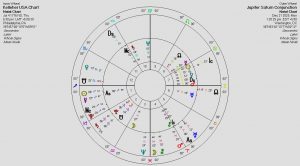 Using a wider orb than three degrees, which is a common technique in Vedic astrology, Jupiter and Saturn will be influencing each other in the first decan of Capricorn for a longer period of time, from March 30 to June 30, 2020. This is a period when we may start to feel or get a glimpse of the energy of the December 2020 conjunction, and especially in the first week of April when Mars, Jupiter, Saturn and Pluto will all conjoin.
Using a wider orb than three degrees, which is a common technique in Vedic astrology, Jupiter and Saturn will be influencing each other in the first decan of Capricorn for a longer period of time, from March 30 to June 30, 2020. This is a period when we may start to feel or get a glimpse of the energy of the December 2020 conjunction, and especially in the first week of April when Mars, Jupiter, Saturn and Pluto will all conjoin.

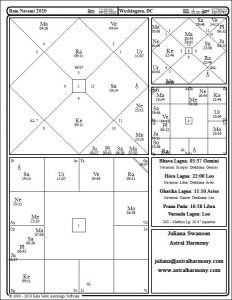 The Jupiter-Saturn cycle occurs every 20 years and is an important one for forecasting important mundane events. Astrologer Charles Harvey wrote about the conjunction in the book Mundane Astrology:
The Jupiter-Saturn cycle occurs every 20 years and is an important one for forecasting important mundane events. Astrologer Charles Harvey wrote about the conjunction in the book Mundane Astrology: “These two planets used to be known as the “Great Chronocrators” or rulers of the ages. Their cycle can be considered the ground base of human development which marks the interaction between the perception of ideas, potentialities, possibilities (Jupiter) and their manifestation in the concrete world (Saturn).”
“These two planets used to be known as the “Great Chronocrators” or rulers of the ages. Their cycle can be considered the ground base of human development which marks the interaction between the perception of ideas, potentialities, possibilities (Jupiter) and their manifestation in the concrete world (Saturn).”
In Vedic astrology, Jupiter is the lord of dharma (duty), purpose, and opportunity, and Saturn is the lord of karma, power, and action. When they conjoin, they can form a powerful raja yoga of “power and purpose” which activates a new phase of social direction, ambition, and worldly achievement. Their conjunction is a time both individually and collectively to establish important new commitments, a process that sets the stage for the next 20-year cycle in society. In my work with clients, I am studying where this conjunction occurs in the natal chart and what it activates to understand more clearly about how it will unfold and what can be done to clarify and maximize the potential that it represents.
Capricorn is the sign of the builder symbolized by a mountain goat who scales great heights of achievement. It is also emblemized by a sea-goat, which is called a makara in Vedic tradition, whose lower half is a crocodile or fish, and whose upper half is a mammal (elephant, deer, or goat). The sea-goat or makara represents the duality of this sign which can manifest as either materialistic or spiritual. Capricorn in its highest expression can represent the perfect balance of each, as it lives in both the material and spiritual realms.
 According to Esoteric Astrology (Alice Bailey), “Capricorn is the zodiac sign in which a new cycle of effort is inaugurated. Effort, strain, struggle, the fight with the forces native to the underworld, or the strenuous conditions entailed by the tests of discipleship or initiation – these are distinctive of experience in Capricorn.” Capricorn is also symbolized by the unicorn, representing the emergence of unity consciousness within the spiritual initiate “(shining with light and one-pointed).”
According to Esoteric Astrology (Alice Bailey), “Capricorn is the zodiac sign in which a new cycle of effort is inaugurated. Effort, strain, struggle, the fight with the forces native to the underworld, or the strenuous conditions entailed by the tests of discipleship or initiation – these are distinctive of experience in Capricorn.” Capricorn is also symbolized by the unicorn, representing the emergence of unity consciousness within the spiritual initiate “(shining with light and one-pointed).”
 The last time Jupiter and Saturn conjoined in sidereal Capricorn was in 1961, almost 60 years ago. It was the beginning of a tumultuous decade that led to a break with the past and enormous changes in the social and political fabric of the United States and the rest of the world, too. It was a time of disillusionment but also awakening, when “much of the world was in a broad state of change:
The last time Jupiter and Saturn conjoined in sidereal Capricorn was in 1961, almost 60 years ago. It was the beginning of a tumultuous decade that led to a break with the past and enormous changes in the social and political fabric of the United States and the rest of the world, too. It was a time of disillusionment but also awakening, when “much of the world was in a broad state of change:
We were moving out of the post-World War II era, and into both the Cold War and the Space Age, with broadening civil rights movements and anti-nuclear protests in the U.S. In 1961, John F. Kennedy was inaugurated as the 35th president of the United States, Soviet cosmonaut Yuri Gagarin became the first human to fly in space, Freedom Riders took buses into the South to bravely challenge segregation, and East Germany began construction of the Berlin Wall. That year, Kennedy gave the okay to the disastrous Bay of Pigs Invasion into Cuba and committed the U.S. to ‘landing a man on the Moon’ with NASA’s Apollo program. JFK also oversaw the early buildup of a U.S. military presence in Vietnam; by the end of 1961, some 2,000 troops were deployed there.” The Atlantic: Taylor, Alan: 50 Years Ago: The World in 1961
5. In November-December 2020, we will see a close conjunction of Jupiter with both Pluto and Saturn, potentially a powerful configuration for a historical turning point. The last time there was a conjunction like this involving Jupiter, Pluto, and Saturn was in 1146 AD when Pope Eugene III reissued the bull Quantum Praedecessores of 1145 calling for the Second Crusade, which began soon thereafter.
6. February 2020 may be a particularly “sensitive” time to be aware of, to be prepared for a Black Swan type event, especially in the third or fourth week of February (or maybe into early March) when the December 2019 solar eclipse chart will be activated by Mars crossing the critical eclipse degree point. My friend, astrologer Joni Patry, describes this point as a “land mine ready to explode.” These degrees can be used to forecast the future. For instance, on 9/11, Mars and Ketu in transit were in full aspect to the luminaries in the June 21, 2001 eclipse chart. This was a huge trigger for a terror event as Mars and Ketu in transit came to the U.S. Kelleher birth chart ascendant on 9/11, and the June 2001 eclipse had also activated natal planets in the 1/7 axis of the Kelleher chart, too (including natal Mars). During this period in February, Mars will again join Ketu in transit and cross the U.S. Kelleher ascendant. For more information, I wrote about it in detail in my recent eclipse article.
7. Mars and Saturn will conjoin in late March in early Capricorn in conjunction with natal Pluto (death-rebirth) in the U.S. Kelleher chart, at the degree where Jupiter and Saturn will also conjoin in December 2020. Mars and Saturn will both be strong in dignity, but will be in a graha yuddha (planetary war) from March 30 through April 1.This can point to some generally difficult times or sudden explosive events (literal and figurative). 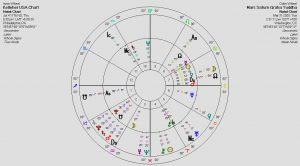 Mars and Saturn conjoined around 6 degrees of sidereal Capricorn in November 1873, shortly after the Panic of 1873 that began in September that year. This financial crisis triggered an economic depression in Europe and North America that lasted for four or more years. When it began, the NYSE temporarily closed, and eventually 55 railroads and 60 banks failed.
Mars and Saturn conjoined around 6 degrees of sidereal Capricorn in November 1873, shortly after the Panic of 1873 that began in September that year. This financial crisis triggered an economic depression in Europe and North America that lasted for four or more years. When it began, the NYSE temporarily closed, and eventually 55 railroads and 60 banks failed.
8. Mercury will retrograde three times in 2020 and this will occur in Air signs (sidereal zodiac), which can have a challenging impact on mental processes, travel, relationships, and communication. It is important to consult a professional astrologer before establishing dates to begin important matters, especially during retrograde Mercury cycles. Mercury will retrograde from:
- February 17 to March 10, 2020
- June 18 to July 12, 2020
- October 14 to November 3, 2020
9. Not to be undone by Mercury, Venus and Mars will also retrograde in 2020. Venus retrogrades for about 42 days approximately every 18-19 months. It will retrograde from May 13 to June 25, 2020 in sidereal Taurus. Retrograde Venus cycle is not a good time for a marriage proposal, engagement, or wedding. It is a time when we often revisit the past and relationships of the past especially, and when we have to re-evaluate matters related to relationship or finances. The natal houses that Venus rules and occupies, and the house it transits in, and aspects it makes to the natal chart, will all show what is emphasized. Venus’ retrograde station will occur at about 28 degrees Taurus and it will station direct at about 11 degrees Taurus.
Mars retrogrades approximately every 26 months for about 80 days. In 2020, it will retrograde from September 9 to November 13. This is considered a potentially inauspicious time in the world when conflict and aggression can become more intense than usual. When Mars retrogrades, its energy becomes stronger for “good or bad” depending on its other temporal significations. Mars, the “Crooked,” moves further than usual from the ecliptic plane when it’s retrograde, so its energy becomes even more “crooked,” i.e., unpredictable.
Mars will station retrograde at about 4 degrees of sidereal Aries, and will transit back to 21 degrees of Pisces where it will make its direct station, and will go forward again and hit the 4 degree point of sidereal Aries again on January 3, 2021. It will go through the potentially dangerous transformational edge/gandanta between Pisces and Aries three times, August 13-20 (pre-shadow); September 30 to October 7; and December 21 to December 27. For those ruled by Mars, or those in Mars cycles (dashas), this retrograde phase, especially through the gandanta, can represent a time of immense soul growth, too.
10. Jupiter retrogrades for about 120 days every year. It will be retrograde from May 14 to September 12, 2020. It will station retrograde at about 3 degrees of sidereal Capricorn, and move back to station direct at 23 degrees of sidereal Sagittarius. It is preferable to have Jupiter in direct motion for establishing important new educational, professional, or business concerns or for a marriage ceremony, but there are workarounds that a professional Vedic electional (Muhurta) astrologer like myself can help you with.
11. Saturn retrogrades for about 4.5 months every year. It will retrograde May 11 at around 8 degrees of sidereal Capricorn, and will station direct at 1 degree of sidereal Capricorn on September 29. As the lord of karma, it is best to have Saturn in direct motion for establishing new and important professional matters, when possible, but again a professional Muhurta astrologer can offer solutions to work around this.
12. A solar eclipse will occur on June 21 (on the solstice) with Rahu, Sun, Moon, and Mercury in the Gemini constellation. There will also be two penumbral (appulse) lunar eclipses occurring on June 5 and July 5, 2020.
13. The transiting lunar nodes will make a significant change from sidereal Gemini and Sagittarius in September 2020, after having been in this sign axis for about 18 months, since March 2019 (North Node-Rahu in Gemini and South Node-Ketu in Sagittarius). The true nodes will change positions on September 19, and the mean nodes will shift on September 23, when Rahu will move into Taurus, its sign of exaltation; and Ketu will move into Scorpio, its sign of exaltation.
Another set of eclipses will occur toward the end of 2020, with a lunar eclipse in sidereal Taurus on November 30, 2020, followed by a solar eclipse in late Scorpio (gandanta) on December 14, 2020.
14. If you have anything important that you want to initiate, and you don’t have the ability to consult a professional astrologer to help you, we have some dates in Vedic astrology called abhuj muhurtas which fall on the holiest days in the Vedic calendar, and because of deep energy movements that occur on these days, which are associated with ancient legends and astrological lore, they are considered to be fully auspicious days for beginning any new important venture.
“Abhuj” refers to something eternal, so the abhuj muhurtas focus on the stability and durability of anything begun on their day. The dates given below are calculated for Washington, DC, but you would need to calculate for your locale, as the dates will sometimes change when you go further west or east. I suggest an online panchanga for this. Note that any time on these days is auspicious, but usually the best times are during the puja times listed in the panchanga, or when the Sun is high in your local sky:
- Vasant Panchami (Saraswati’s Birthday): January 29, 2020
- Vedic New Year, beginning of Chaitra Navratri: March 24, 2020 (I use this one as it marks the day that Lord Brahma created our world. It is not traditionally used as an abhuj muhurta by everyone)
- Ram Navami: April 2, 2019
- Akshaya Tritiya: April 25, 2020
- Vijayadashami/Dusshera: October 25, 2019 (after Navratri)
- Diwali: Dhanteras: November 12, 2020 and Lakshmi Puja: November 14, 2020
Maha Shivaratri is not an abhuj muhurta but is a very holy day/night for many of us, which will occur on February 21, 2020. Also Guru Purnima is an important holy day which will occur on July 4, 2020 this year (also it is a lunar eclipse day); and so are the two main Navratri festivals which will take place from March 24 to April 1, 2020, and October 17-25 (though not abhuj muhurtas).
As always, I will be blogging more here and also posting more regular updates on my Astral Harmony Facebook page so please stay tuned for more detailed and specific information as the year unfolds. Remember, “With our thoughts, we make the world.” So, let’s make it a great one!


